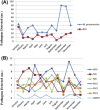Etiology of community-acquired pneumonia in 1500 hospitalized children
- PMID: 28975629
- PMCID: PMC7166354
- DOI: 10.1002/jmv.24963
Etiology of community-acquired pneumonia in 1500 hospitalized children
Abstract
Childhood community-acquired pneumonia (CAP) is a common illness; however, comprehensive studies of hospitalizations for CAP among children in China based on prospective and multicenter data collection are limited. The aim of this investigation was to determine the respiratory pathogens responsible for CAP in hospitalized children. From January to December 2015, oropharyngeal swabs and blood serum were collected from hospitalized children with CAP symptoms ranging in age from 6 months to 14 years at 10 hospitals across China. We used immunofluorescence to detect antibodies for eight respiratory viruses and passive agglutination to detect specific IgM against Mycoplasma pneumoniae (M. pneumoniae). Of 1500 children presenting with CAP, 691 (46.1%) tested positive for at least one pathogen (virus or M. pneumoniae). M. pneumoniae (32.4%) was detected most frequently, followed by respiratory syncytial virus (11.5%), adenovirus (5.0%), influenza A virus (4.1 %), influenza B virus (3.4%), parainfluenza virus types 2 and 3 type (3.1 %), parainfluenza virus type 1 (2.9%), and human metapneumovirus (0.3%). Co-infections were identified in 128 (18.5%) of the 691 cases. These data provide a better understanding of viral etiology and M. pneumoniae in CAP in children between 6 months and 14 years in China. More study of the etiologic investigations that would further aid the management of pneumonia is required. With effective immunization for RSV, ADV, and M. pneumoniae infections, more than one-half of the pneumonia cases in this study could have been prevented.
Keywords: Mycoplasma pneumoniae; children; community-acquired pneumonia; multicenter research; respiratory viruses.
© 2017 Wiley Periodicals, Inc.
Figures



References
-
- Zar HJ, Ferkol TW. The global burden of respiratory disease—impact on child health. Pediatr Pulmonol. 2014; 49:430–434. - PubMed
-
- World Health Organization (WHO). Pneumonia Fact Sheet. World Health Organization Report 2016; WHO:Geneva, Switzerland.
Publication types
MeSH terms
LinkOut - more resources
Full Text Sources
Other Literature Sources
Miscellaneous

